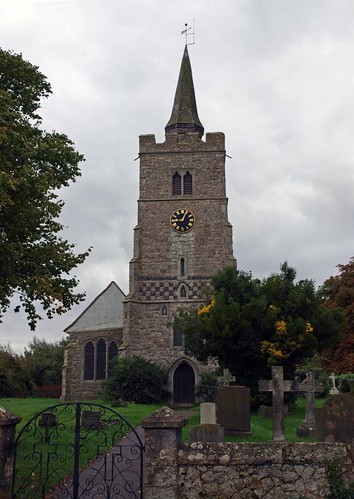ALL SAINTS. Stately W tower with diagonal buttresses with three set-offs, ogee-headed niches l. and r. and above the W window, a frieze of flint and stone chequer above the window, battlements and a recessed boarded spire. Late Perp (Tudor) the N aisle with its two- and three-light windows without tracery and its concave-sided relatively tall and slender octagonal arcade piers. Rood stairs in the N wall. - FONT. Perp, octagonal, with shields, quatrefoils etc. - PULPIT. With big tester and back wall with a big odd-shaped panel flanked by volutes. - SCULPTURE. Two headless alabaster figures, C15, one seated, the other standing, only 12 and 15in. long.- PLATE. Cup of 1562 with two bands of ornament; Paten of 1568.
BARLING. A very old place on a creek at the mouth of the Roche, its church belongs to St Paul’s Cathedral, given to it by Edward the Confessor. The bishops had a prison in this remote corner of England, and 15 feet of rubble wall on Jail Farm is said to have been part of it. The fields are flat and open, and in one stands a wooden mill, its sailless cap like a dingy sunbonnet on a little Dutch lady. Not far away is the massive medieval tower with a slender shingle spire. We come into the church by a modern doorway set in a Norman arch; the other old doorway has been blocked up but still keeps two quaint heads five or six centuries old. The Jacobean pulpit has a great sounding-board, and among the things that are treasured here are ancient pewter plates, a 14th century coffin lid, and fragments of alabaster figures from a medieval reredos with traces of colour still on them.

No comments:
Post a Comment